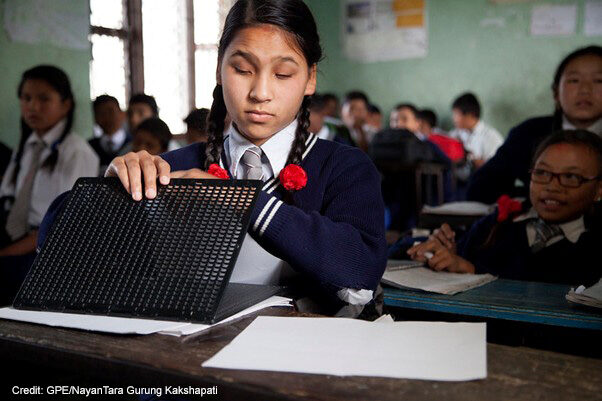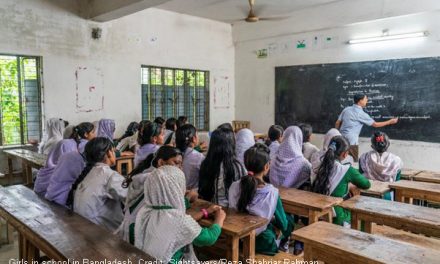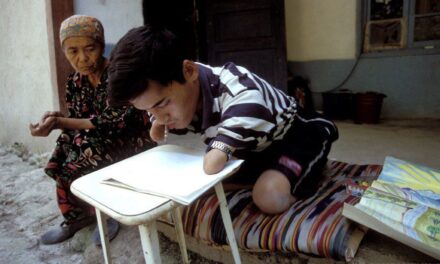This blog was written by Nidhi Singal, Charlotte McClain-Nhlapo and Hanna Alasuutari. It was originally published on the World Bank Education for Global Development Blogs on 1 April 2025.
The third Global Disability Summit takes place this week in Berlin, and policymakers, educators, and civil society actors attending will reflect on the progress made in making education more inclusive, and what challenges remain to be tackled. Education is crucial because it is a key building block for good jobs, the surest way out of poverty. All children, including children with disabilities, deserve the opportunity to be in school and learn so they acquire the skills and knowledge to thrive and eventually have jobs. While there has been some headway made in the 10 years since the paper “Towards a Disability Inclusive Education,” there is still much more that needs to be done.
While school attendance in low- and middle in-come countries for children with disabilities has increased, challenges within schools in relation to regular attendance, progression, attainment, and social inclusion remain. Transitions across different levels of the education system and into future employment also remain of concern, and the economic and social fallout of exclusion is high.
Many of these barriers are not insurmountable. Issues such as physical inaccessibility of schools, lack of adapted and accessible teaching and learning materials, inadequate initial teacher education and continuous professional development, and poor access to assistive technology require a systemic approach to mainstreaming and strengthening educational reform efforts.
These challenges are compounded by increasing incidence of humanitarian crises, the effects of climate change, and other emergencies (such as the COVID-19 pandemic), all of which have a disproportionate impact on persons with disabilities.
Accelerating action
So how can we accelerate efforts to help children with disabilities access quality education?
At the Pre-Global Disability Summit on Education at Hughes Hall, University of Cambridge in September 2024, hosted by the Faculty of Education at the University of Cambridge, the Cambridge Network for Disability and Education Research, the World Bank, UNICEF, the International Disability Alliance, and Christian Blind Mission, representatives of 30 organisations came together to put forward some concrete ideas. Seven areas stand out:
- Create a policy roadmap to enhance inclusion in education systems tailored to each country’s needs. This could involve forming an inclusive education policy, enforcing laws, building capacity, designing appropriate curriculum and assessments, strengthening accountability, or scaling innovative solutions.
- Enhance national education data systems, program monitoring, and use of contextually relevant research for decision-making. Reliable data should be used to inform programme and policy design. Use the Washington Group/UNICEF Child Functioning Model tool to gather disability prevalence data in censuses and programs, collaborating with organisations of persons with disabilities and civil society organisations.
- Ensure data systems include all learners with disabilities, both in and out of school, and allow disaggregation by gender. Governments should integrate health, education, and social welfare data systems to provide early intervention and continuous services for children with disabilities, debilitating health conditions, or those at risk.
- Use universal design principles for accessible infrastructure and flexible curricula to meet diverse student needs. Ensure schools provide safe, inclusive environments for students with disabilities. Invest in educating school leaders about their responsibilities. Strengthen local systems to produce affordable assistive devices and accessible educational technologies, suited to local needs.
- Amplify the visibility of disability and the inclusive education agenda. Empower youth with disabilities by creating social media campaigns and offering training and platforms for them to share their stories, collaborate with influencers, content creators, and media outlets to raise awareness and promote global dialogue on disability issues through accessible digital content.
- Foster intersectoral collaboration and recognise the roles of new stakeholders. Enhance collaboration among policymakers, civil society organisations, disability organisations, private sector actors, communities, families, and learners with disabilities. Collaborating with higher education institutes is important to enable learners with disabilities to transition to university and work and responding to new research priorities.
- Boost investments in disability-inclusive education through consistent domestic and donor financing, and innovative funding methods. Key players should form creative partnerships and explore new financing mechanisms to ensure increased funds, focusing on empowering organisations of persons with disabilities.
Moving beyond incremental change
The gathering in Berlin provides a crucial opportunity to move beyond incremental change and drive systemic reform. The seven priority areas identified offer a clear and actionable path forward. However, these efforts require sustained political commitment, innovative funding mechanisms, and the development of new and stronger partnerships.





